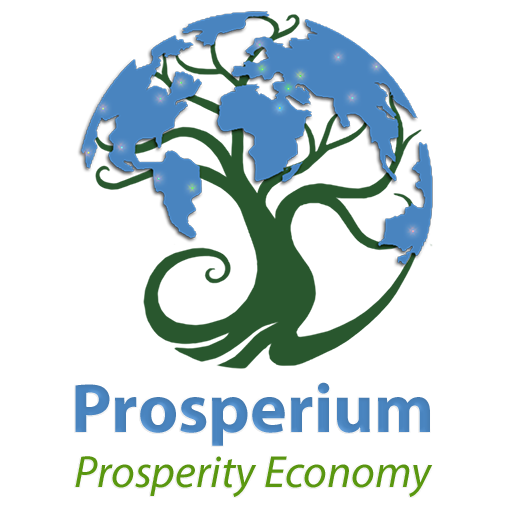 What does the Blockchain Revolution have to do with global prosperity and what’s this new cybercurrency called Prosperium?
What does the Blockchain Revolution have to do with global prosperity and what’s this new cybercurrency called Prosperium?
Let’s start with the bestselling book Blockchain Revolution, by technology guru Don Tapscott and his son Alex, a former investment banker. I recently re-read the book in preparation for a series of blogs I am doing for a cybercurrency start-up called Prosperium (http://www.prosperium.io/). Prosperium promotes and more importantly intends to generate actual community prosperity. This blog you’re now reading is the debut of that series.
My connection with the firm is through a serial entrepreneur and Canadian internet commerce pioneer named Tony Humble, who was the co-founder of Basis 100 (BAS: TSX). I have previously done business with Tony via The Wealthy Boomer magazine and website (which ran from 1999 to 2005) and later my financial novel Findependence Day, which spawned the Financial Independence Hub (where you’re reading this blog.)
We’ll look at Prosperium and its business model specifically in the follow-up blog to this, including interviews with Prosperium’s founder, Doug Coyle (shown in photo near the end of this blog). But let’s focus first on Blockchain Revolution, since the book is as its title implies a revolutionary blueprint for all things fin-tech, including cybercurrencies like the original Bitcoin and everything spawned in its wake, including Canadian-inspired firms like Ethereum and now Prosperium.
I attended the original launch of the Tapscotts’ book at the Rotman School on May 5, 2016 and you can find my review at the Financial Post and a subsequent one on the Hub. The FP review ran the day after the launch, and the headline is as good a place to kick off this second look at the book: Bitcoin and Blockchain could be the start of a bigger revolution than the Internet itself.

Rather than repeat my points in this limited space I refer readers first to that review and then to my first Hub review of the book, which ran on June 1st, 2016. At the end you can find a link to a half-hour YouTube video produced by ThatChannel.com in which Norman Evans (the Hub’s creative director) and I interviewed both Tapscotts and some others who attended the Rotman launch.
Blockchain promises a quantum leap in global prosperity
So what did I get out of the book by rereading it a second time a year later? For starters, the first time was hard copy and the second was a Kindle version (below I refer readers to Kindle locations for extracts); my approach to the re-read was largely through the lens of prosperity and what I have learned about the Blockchain’s potential to bring prosperity to far more of this planet’s citizens – including the 2 billion so-called “unbanked.” As the book makes clear, the blockchain means anyone equipped with a smartphone and Internet access anywhere on the planet can access banking services and much more.

“The book’s main theme is the power of the blockchain to increase global prosperity,” notes Tony Humble, “It runs through everything I’ve read” in the book. For example, he points to what the authors write at Kindle locations 603 to 605, “Billions of excluded people can soon enter the global economy … We can each own our identities and our personal data. We can do transactions, creating and exchanging value without powerful intermediaries acting as the arbiters of money and information.”
Then, at Kindle location 814 to 818, the authors argue blockchain “should succeed, because it could help us usher in a new era of prosperity … It drastically lowers the cost of transmitting such funds as remittances. It significantly lowers the barrier to having a bank account, obtaining credit, and investing. And it supports entrepreneurship and participation in global trade. It catalyzes distributed capitalism, not just a redistributed capitalism.”
Financial industry ripe for disruption
As my original reviews noted, few industries are riper for disruption than the $100 trillion dollar financial services business, which the authors quip is “the world’s second oldest profession.” In the book, they liken the industry to a Rube Goldberg contraption based on a “byzantine system of intermediaries,” some still running on 1970s-era mainframe computers.
Certainly, Alex Tapscott’s background in finance (he is the founder and CEO of Northwest Passage Ventures) makes the book that much more relevant. At Kindle locations 1984-1986 the Tapscotts write “the unstoppable force of blockchain technology is barreling down on the entrenched, regulated, and ossified infrastructure of modern finance. Their collision will reshape the landscape of finance for decades to come. We would like it to finally transform from an industrial age money machine into a prosperity platform.” As Don told me at the book launch, “instead of redistributing wealth, we can change the way wealth is created in the first place.”
There are clear political implications here, which is why Governments around the world – as well as the big banks – are frantically getting up to speed on blockchain and fintech. What government doesn’t want prosperity for its citizens? The book makes an intriguing comment that “the industrial complex continues to generate wealth, but not prosperity.”
 We could write an entire blog on the subtle differences between prosperity, wealth and financial independence. Merriam-Webster defines prosperity simply as “the condition of being successful or thriving, especially: economic well-being.” It defines Wealth as “abundant supply” or “all property that has a money value or an exchangeable value.” They don’t define financial independence but I view it as the fruit of Wealth and Prosperity applied at the individual level, and that fruit is largely freedom and the means to do what you want.
We could write an entire blog on the subtle differences between prosperity, wealth and financial independence. Merriam-Webster defines prosperity simply as “the condition of being successful or thriving, especially: economic well-being.” It defines Wealth as “abundant supply” or “all property that has a money value or an exchangeable value.” They don’t define financial independence but I view it as the fruit of Wealth and Prosperity applied at the individual level, and that fruit is largely freedom and the means to do what you want.
So it’s not that big a leap to say that if the blueprint for early adopters, industry and government leaders provided by Blockchain Revolution is at all on target, a new era of global prosperity will also bring about the aim of this particular website: Financial Independence not just for privileged North Americans but for the entire world.
A revolution indeed!
Full disclosure: I am being paid for writing this and the related blogs, in part with good old-fashioned dollars, but primarily in what I hope will be much more valuable compensation in the form of Prosperium. As we’ll note in the next blog that looks at this model, the initial value of Prosperium is set at $2 per unit but after a series of presales to accredited investors, the current aim is to reach $100 by the time it becomes available to the general public at a stabilized value.


